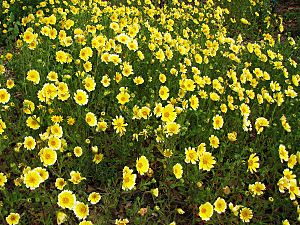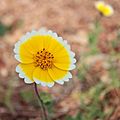Coastal tidytips facts for kids
Quick facts for kids Coastal tidytips |
|
|---|---|
 |
|
| Scientific classification | |
| Genus: |
Layia
|
| Species: |
platyglossa
|
Layia platyglossa, often called coastal tidytips, is a beautiful wild flower. It grows every year from a seed, meaning it's an annual plant. This flower belongs to the Asteraceae family, which also includes daisies and sunflowers. You can find it naturally in western North America.
Contents
Where Do Tidytips Grow?
Coastal tidytips used to be very common in dry areas of California, including the Mojave Desert. They also grew in Arizona and Utah. Before European settlers arrived, these plants covered large areas at lower elevations.
You can find them in grassy valleys, on hillsides, and in open spaces within coastal sage scrub and chaparral areas. They also thrive on coastal plains and in the High Desert. These flowers are part of the amazing spring wildflower displays, blooming from March to June.
What Do Tidytips Look Like?
Layia platyglossa is an annual plant that feels a bit rough and has tiny glands. It looks like a daisy with narrow, hairy leaves. The whole plant is usually less than 1 foot (0.30 m) tall, often around 4–12 inches (10–30 cm) wide. It usually has a main root that goes deep, but sometimes it has many smaller, fibrous roots.
The leaves near the top of the stem are short and hairy. The leaves at the bottom of the stem can be toothed or deeply cut with round, short sections. Generally, the lower leaves are lobed (have rounded parts), while the upper leaves are smooth. Leaves usually grow one after another along the stem, or sometimes in pairs.
Its Unique Flowers
The tidytips plant produces many flower heads that grow on stalks. The stems usually stand upright, but can also spread out or grow upwards. They are strong and have branches that form a rounded shape.
Each flower head has five to eighteen bright yellow petals, called ray flowers, which have distinct white tips. In the center, there are many small yellow disk flowers. The white tips on the outer petals make the flower look "tidy," which is how it got its name! The green parts that hold the flower head (bracts) are rounded at their tips.
Insects help pollinate these flowers, which means they help the plant make seeds. The fruits are usually dry and tough. The seeds are spread by the wind, often with the help of a feathery structure called a pappi. Each fruit contains one seed.
Why Are Tidytips Important?
Coastal tidytips are grown for several reasons.
Grown for Beauty
People grow Layia platyglossa as an ornamental plant because its daisy-like flowers are very pretty. It's often included in mixes of wildflower seeds that people buy. These flowers are popular in traditional gardens, and also in wildlife gardens and habitat gardens because they attract helpful insects.
Helping Nature
This wildflower is used in restoration projects to help bring natural habitats back to health. It's a great plant for supporting pollinators, like bees and butterflies. When the seeds are ripe, they also become a food source for birds.
Gallery




